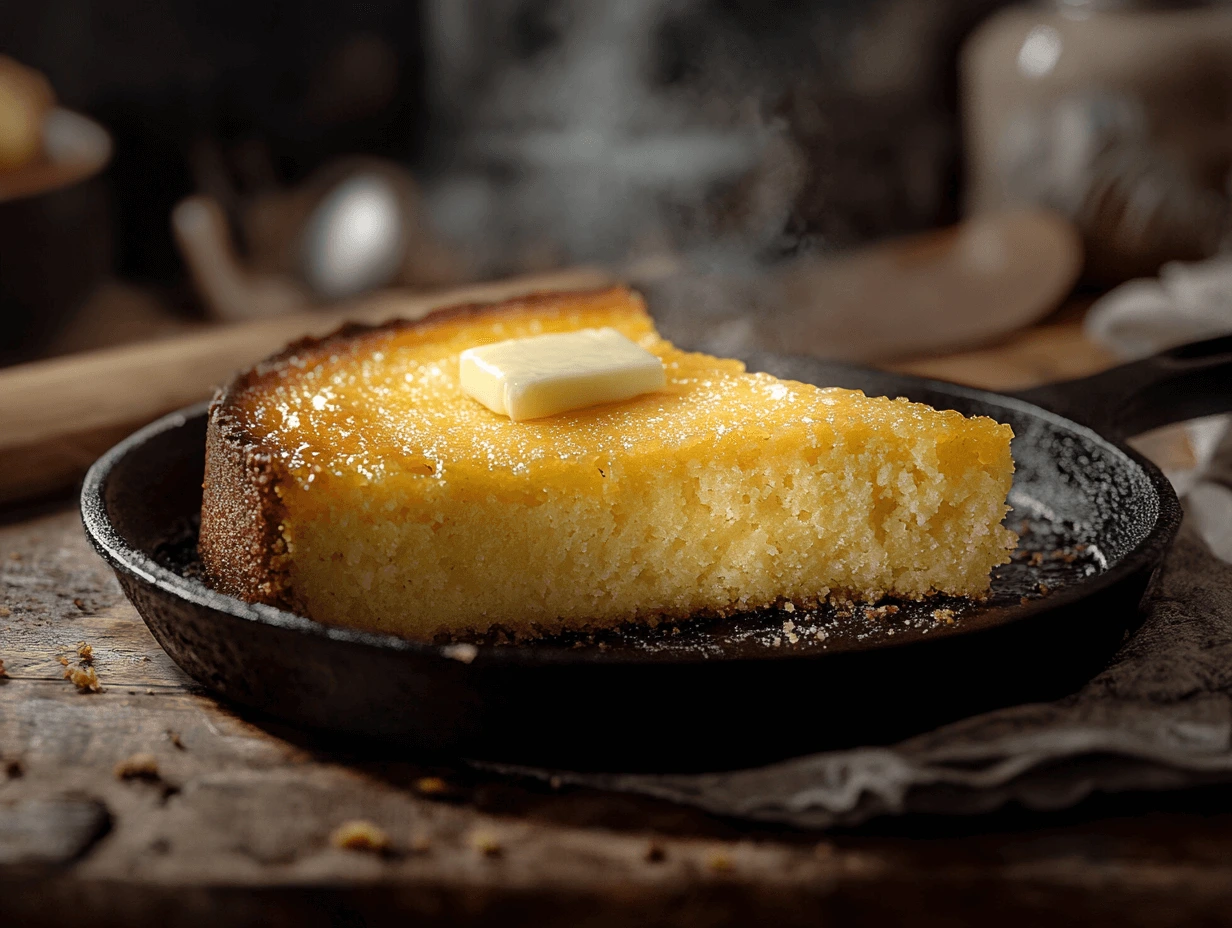Discover the authentic taste of a classic Southern cornbread recipe beef tallow. It turns your kitchen into a Southern culinary haven. This recipe uses beef tallow, a secret ingredient that makes it special. It’s crafted with precision and passion, ensuring a rich, golden-brown delight.
Table of Contents
Beef tallow adds an unparalleled depth of flavor to this cornbread. It creates a crispy exterior and a moist, tender interior. Your homemade cornbread will be the star of family gatherings and weekend meals.
Key Takeaways
- Authentic Southern cornbread requires specific ingredients and techniques
- Beef tallow provides superior flavor and texture
- Traditional cast iron skillet cooking is essential
- No sugar approach maintains a true Southern cornbread experience
- Proper preparation ensures a crispy exterior and tender crumb
- Temperature and ingredient quality are crucial for success
- Cornbread represents more than food—it’s a cultural tradition
The Heritage and History of Southern Cornbread
Southern cornbread has a deep history in American farming traditions. It has grown from a basic food to a symbol of comfort and heritage in Southern homes.
The roots of cornbread go back to Native American cooking. Corn was a key crop for many tribes. They developed ways to grind and use cornmeal that shaped Southern cooking.
Traditional Cooking Methods and Ingredients
Old Southern cornbread recipes were unique. They used special methods, like no eggs, when ingredients were scarce. This showed the creativity of home cooks.
- Cast iron skillet preparation
- Stone-ground cornmeal preferences
- Minimal ingredient philosophy
Evolution of Cornbread in Southern Cuisine
The use of lard made Southern cornbread special. It added a unique flavor and texture. Recipes were passed down, with each family adding their own twist.
“Cornbread isn’t just food—it’s a cultural expression of Southern resilience and creativity.”
Why Beef Tallow Makes a Difference
Beef tallow in cornbread recipes adds depth and complexity. It brings a flavor that modern oils can’t match.
| Ingredient | Traditional Impact | Flavor Profile |
|---|---|---|
| Beef Tallow | Authentic Preparation | Rich, Deep Umami |
| Precooked Cornmeal | Consistent Texture | Smooth, Even Crumb |
| No Eggs | Historical Adaptation | Dense, Rustic Consistency |
Knowing cornbread’s history shows its importance beyond just food. Each recipe shares a tale of adaptation, survival, and innovation that still inspires cooks today.
Essential Ingredients for Authentic Southern Cornbread Recipe Beef Tallow
To make the perfect white cornmeal cornbread, you need top-notch ingredients. These ingredients bring the real taste of the South to your home. The key to a great cornbread is using the right parts that blend well together.
- White cornmeal: The star ingredient for traditional Southern cornbread
- Beef tallow: Provides rich, deep flavor and exceptional texture
- Self-rising flour: Ensures perfect rise and tender crumb
- Fresh eggs: Bind ingredients and add moisture
When making cornbread with cornmeal mix, focus on the quality of your ingredients. Buttermilk is key for that tangy taste and soft texture. This is what Southern cooks have mastered over the years.
| Ingredient | Purpose | Recommended Quantity |
|---|---|---|
| White Cornmeal | Primary Base | 1 cup |
| Beef Tallow | Fat and Flavor | 1/4 cup |
| Buttermilk | Moisture and Tanginess | 1 cup |
| Self-Rising Flour | Structure and Rise | 1/2 cup |
Your cornbread will be light and fluffy with self-rising flour. The secret is using fresh, quality ingredients and handling them with care.
“Good cooking is about passion, technique, and understanding your ingredients.” – Southern Cooking Wisdom
Each ingredient adds its own special touch to the cornbread. Beef tallow brings depth, cornmeal adds authenticity, and buttermilk makes it tender. This is true Southern cooking at its best.
The Perfect Cast Iron Skillet Preparation
Making a killer cornbread recipe begins with mastering your cast iron skillet. The right preparation can turn your yellowstone cornbread recipe into something amazing. Cast iron skillets are key in Southern baking. They distribute heat well and give a crispy, golden crust.
Seasoning Your Skillet
Seasoning your skillet is key to prevent sticking and create a non-stick surface. Follow these steps:
- Clean the skillet with hot water
- Dry it with a clean towel
- Apply a thin layer of beef tallow or vegetable oil
- Bake upside down at 450°F for one hour
Temperature Control Tips
Keeping the temperature consistent is crucial for perfect cornbread. Here’s a quick guide:
| Temperature Range | Cornbread Result |
|---|---|
| 325-350°F | Soft, cake-like texture |
| 400-425°F | Crispy exterior, moist interior |
| 450-475°F | Extra crispy, deep golden crust |
Preheating Techniques
For the ultimate cornbread, preheat your skillet in the oven. Hot skillet, hot oil is the key. Put your cast iron in the oven while it heats up. Add a tablespoon of beef tallow or oil for a sizzling surface. This ensures a perfectly crisp bottom.
“A well-seasoned skillet is like a culinary treasure passed down through generations.” – Southern Cooking Wisdom
Step-by-Step Mixing and Baking Process
Making the perfect white cornbread recipe needs precision and care. Start by gathering all ingredients and preparing your workspace. This is the first step in your cornbread no sugar recipe.
- Combine dry ingredients in a large mixing bowl:
- Stone-ground white cornmeal
- All-purpose flour
- Baking powder
- Salt
- Whisk wet ingredients separately:
- Room temperature eggs
- Melted beef tallow
- Buttermilk
- Gently fold wet ingredients into dry mixture
Mixing technique is key for the right cornbread texture. Do not overmix – mix until just combined to avoid tough bread.
“The secret to great cornbread is respecting the batter’s delicate balance.” – Southern Cooking Tradition
Preheat your cast iron skillet with beef tallow until it’s sizzling hot. Pour the batter smoothly for a golden crispy crust.
| Ingredient | Quantity | Purpose |
|---|---|---|
| White Cornmeal | 1 cup | Base texture |
| Flour | 1/2 cup | Structure |
| Beef Tallow | 1/4 cup | Rich flavor |
Bake at 425°F for 20-25 minutes. The top should turn golden brown and a toothpick should come out clean. Let it rest for 5 minutes before serving your authentic Southern white cornbread.

Troubleshooting Common Cornbread Problems
Making the perfect southern cornbread recipe can be tricky. Even experienced home cooks face challenges. Knowing the common issues helps make a delicious cornbread recipe no sugar every time.
Texture Challenges and Smart Solutions
Cornbread texture is key to a great dish. Common problems include:
- Dry, crumbly texture: Often caused by overmixing or using too much cornmeal
- Dense, heavy bread: Typically results from incorrect flour-to-meal ratio
- Uneven baking: Usually indicates inconsistent oven temperature
Temperature Adjustment Strategies
Precise temperature control is crucial for southern cornbread. Your cast iron skillet should be preheated to around 425°F before adding batter. This ensures a crispy exterior and moist interior.
| Temperature Issue | Solution |
|---|---|
| Undercooked center | Lower oven rack, reduce temperature to 375°F |
| Burnt exterior | Cover with aluminum foil, reduce temperature by 25 degrees |
Smart Storage and Reheating Tips
Preserve your southern cornbread’s quality by following these guidelines:
- Cool completely before storing
- Wrap tightly in plastic wrap or aluminum foil
- Refrigerate for up to 3 days
- Reheat in oven at 350°F for best results
“Perfect cornbread is an art form that requires patience and practice.” – Southern Cooking Tradition
Conclusion
Making an authentic southern cornbread recipe with beef tallow is more than cooking. It’s about keeping culinary traditions alive. Your journey through this recipe connects you to generations of Southern cooks.
Each golden, crispy slice of cornbread tells a story. It’s about flavor, technique, and cultural pride. This is what makes southern cornbread special.
The secret to amazing southern cornbread with beef tallow is in the details. You’ve learned about choosing the right cast iron skillet and controlling temperature. These small steps make a big difference in the taste.
Your dedication to making it right will show in every batch. You’ll make it even better with each try.
Don’t be afraid to try new things while keeping traditional methods in mind. Your skills let you make this classic recipe your own. You can serve it with stews or enjoy it on its own.
Remember, cooking is about love and learning. Every time you make this cornbread, you’ll get better. You’ll love this Southern staple even more.
Your kitchen is now a place where old traditions meet new ideas. You create delicious memories with every slice.
FAQ
What makes Southern cornbread different from other cornbread recipes?
Southern cornbread uses white cornmeal and little sugar. It’s baked in a cast iron skillet with beef tallow or lard. This makes it savory and crispy on the outside, yet moist inside.
Can I make cornbread without eggs?
Yes, you can make Southern-style cornbread without eggs. Use cornmeal, buttermilk, and beef tallow for a moist bread. Buttermilk replaces eggs, adding moisture and flavor.
What type of cornmeal should I use for authentic Southern cornbread?
Use stone-ground white cornmeal or a Southern-style cornmeal mix. Avoid sweet yellow cornmeal for a savory taste.
Why do Southern cooks prefer using a cast iron skillet?
Cast iron skillets heat evenly, making the cornbread crispy and golden. They also add flavor and prevent sticking.
Is it necessary to use beef tallow in the recipe?
Beef tallow is traditional and adds flavor. But, you can use lard or vegetable shortening as substitutes. Beef tallow gives a unique taste to Southern cornbread.
How do I prevent my cornbread from becoming dry?
Use buttermilk and don’t overmix the batter. Avoid overbaking. Preheat the skillet with tallow or oil for a crispy exterior and moist inside.
Can I make cornbread without sugar?
Yes! Authentic Southern cornbread has little to no sugar. This lets the cornmeal and beef tallow flavors shine, making it rustic and traditional.
What’s the best way to store leftover cornbread?
Store it in an airtight container at room temperature for 2-3 days. Wrap it in plastic wrap or foil for longer storage. Freeze for up to a month, ensuring it’s cooled first.
Did you tried this Recipe ?
There are no reviews yet. Be the first one to write one.

